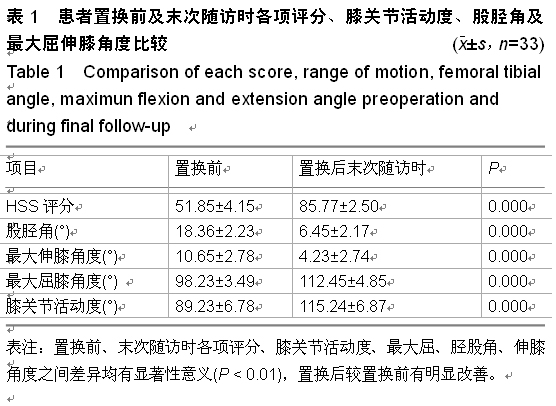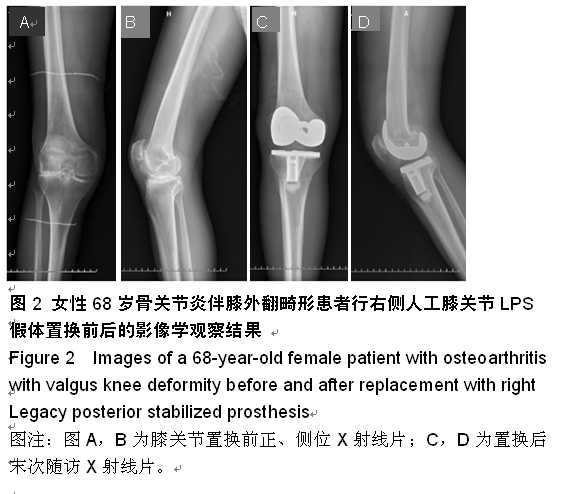| [1] 姚舒,张育民,宋伟,等.严重膝外翻全膝关节置换治疗的疗效观察[J].实用骨科杂志,2013,19(9):792-794.
[2] Elkus M, Ranawat CS, Rasquinha VJ, et al. Total knee arthroplasty for severe valgus deformity. Five to fourteen-year follow-up. J Bone Joint Surg Am. 2004;86-A:2671-2676.
[3] Ranawat AS, Ranawat CS, Elkus M, et al. Total knee arthroplasty for severe valgus deformity. J Bone Joint Surg Am.2005;87:271-284.
[4] Elkus M, Ranawat CS, Rasquinha VJ, et al. Total knee arthroplasty for severe valgus deformity. J Bone Joint Surg Am. 2004;86:2671-2676.
[5] 任姜栋,张晓岗,曹力,等.重度膝关节外翻畸形的全膝关节置换术[J].中华骨科杂志,2014,36(4):645-651.
[6] 李广伟.全膝关节置换治疗成人膝外翻畸形:胫股角及膝关节活动度变化[J].中国组织工程研究,2012,16(26):4786-4791.
[7] 徐美涛,查振刚,刘宁,等.人工全膝关节置换术在外翻膝的临床应用[J].中国矫形外科杂志,2011,19(2):109-112.
[8] 曹光磊,沈惠良,冯明利,等.髌旁外侧入路进行外翻膝人工全膝关节置换术的探讨[J].中华临床医师杂志,2012,6(3):622-625.
[9] Bardakos N, Cil A, Thompson B, et al. Mechanical axis cannot be restored in total knee arthroplasty with a fixed valgus resection angle: a radiographic study. J Arthroplasty. 2007;22: 85-89.
[10] 唐成,严俊伟,王黎明,等.选择性软组织松解技术在重度膝外翻畸形全膝关节置换术中的应用[J].中国骨与关节损伤杂志,2014, 29(6):547-549.
[11] 区文欢,陈述祥.初次人工全膝关节表面置换术治疗膝关节骨关节病108例的疗效观察[J].中国矫形外科杂志,2011,19(17): 1427-1430.
[12] 王浩汀,周一新.髌旁内外侧入路在外翻膝人工全膝关节置换术中的应用研究[J].中国医师杂志,2015,17(2):298-300.
[13] 王友,侯筱魁,戴尅戎,等.改良髌旁外侧入路用于外翻膝人工全膝关节置换术[J].中华骨科杂志,2001,21(12):714-717.
[14] 周殿阁,张斌,寇伯龙,等.膝外翻全膝关节置换外侧髌旁入路的手术方法探讨[J].中华医学杂志,2007,87(27):1885-1889.
[15] 吕厚山,关振鹏,周殿阁,等.膝关节外翻畸形的人工全膝关节置换术[J]. 中华外科杂志,2005,43(20):1305-1308.
[16] 贾效敏,王君峰,石南征,等.全膝关节置换治疗膝关节外翻畸形9例[J].中国组织工程研究与临床康复,2010,14(30): 5555-5558.
[17] Keblish PA. Valgus deformity in total knee replacement (TKA):The lateral retinacular approach, 1985:28-29.
[18] 马军,主动生,尚小可,等.全膝关节置换治疗严重外翻畸形的临床研究[J].中国矫形外科杂志,2011,19(11):897-899.
[19] 曾伟,魏艳珍,高曦,等.软组织平衡在膝外翻畸形全膝关节置换术中的意义[J].中华损伤与修复杂志:电子版, 2009,4(2): 212-215.
[20] 徐美涛,查振刚,刘宁,等.人工全膝关节置换术在外翻膝的临床应用[J].中国矫形外科外科杂志,2011,19(2):109-122.
[21] Palmer DH, Mulhall KJ, Thompson CA, et al. Total knee arthroplasty in juvenile rheumatoid arthritis. J Bone Joint Surg Am. 2005; 87:1510-1514.
[22] 李宝文.全膝人工关节置换涉及的生物力学变化[J].中国组织工程研究与临床康复,2008,12(17):3313-3316.
[23] 汤长华,王黎明,姚庆强,等.标准型股骨髁、胫骨托与高切迹胫骨聚乙烯垫组合TKA治疗严重膝关节骨性关节炎并膝内、外翻畸形[J].中国骨与关节损伤杂志,2014,29(12):1265-1266.
[24] 张洪美,赵铁军,孙钢,等.全膝关节置换术中胫骨近端骨缺损的处理[J].中华骨科杂志,2007,27(5):347-350.
[25] 蔡谞,王岩,王继芳,等.自体打压植骨修复膝关节置换术中胫骨平台骨缺损[J].中华医学杂志,2008,88(41):2907-2911.
[26] 王海强,韩一生,朱庆生.全膝关节置换术中的软组织平衡[J]. 中华骨科杂志,2004;24(4):241-243.
[27] 史法见,张镇,王芳,等.全膝关节置换术治疗膝外翻畸形疗效观察[J].实用骨科杂志,2011,17(8):701-703.
[28] Seebacher JR,Inglis AE,Marshall JL,et al. The structure of the posterolateral aspect of the knee. J Bone Ioint Surg Am. 1982; 64(4):536-541.
[29] 王呈,王韶进,刘文广,等.全膝关节置换术中外翻畸形的软组织平衡[J].山东大学学报(医学版),2005,43(12):1193-1194.
[30] 冯宗权,陈坚锋,潘耀成,等.全膝关节置换术治疗膝外翻畸形的手术探讨[J].中国矫形外科杂志,2014,22(17):1563-1567.
[31] Krackow KA, Mihalko WM. Flexion-extension joint gap changes after lateral structure release for valgus deformity correction into total knee arthroplasty:acadaveric study. J Arthroplasy. 1999;14(8):994-1004.
[32] Mihalko WM, MillerC, Krackow KA. Total knee arthroplasty ligament balancing and gap kinematics with posterior cruciate ligament retention and sacrifice. Am J Orthop. 2000;29(8): 610-616.
[33] 韦兆祥,商晓军,王益民,等. 软组织平衡对全膝关节置换时膝外翻畸形的矫正作用关节[J].解放军医学杂志,2011,36(6): 682-683.
[34] Krackow KA, Mihalko WM. Flexion-extension joint gap changes after lateral structure release for valgus deformity correction in total knee arthroplasty: a cadaveric study. J Arthroplasty. 1999;14:994-1004.
[35] Miyasaka KC, Ranawat CS, Mullaji A. 10- to 20-year followup of total knee arthroplasty for valgus deformities. Clin Orthop Relat Res.1997;(345):29-37.
[36] Install JN,Easley ME. Surgical techniques and instrumentation in total knee arthroplasty. Surgery of the knee. Churchill Livingston, Philadelphia, 2001:1717-1738.
[37] Whiteside LA. Correction of ligament and bone defects in total arthroplasty of the severely valgus knee. Clin Orthop Relat Res. 1993;(288):234-245.
[38] 周新华,唐竞,吴坚,等.滑移截骨术在人工膝关节置换治疗膝外翻畸形中的应用[J].中华医学杂志,2014,94(25):1963-1965.
[39] 李为,蒋毅,周一新,等.高屈曲度人工全膝关节置换术的临床疗效[J].中华骨科杂志,2008,28(10):828-832.
[40] 韦兆祥,商晓军,王益民,等.软组织平衡对全膝关节置换时膝外翻畸形的矫正作用观察[J].解放军医学杂志,2011,36(6):682-682.
[41] 胡如印,田晓滨,孙立,等.应用Nexgen LPS-Flex人工膝关节置换治疗重度膝关节退行性骨关节病126例的早期效果[J].中国组织工程研究与临床康复,2011,15(39):7266-7270.
[42] Carother JT, KimRH, Dennis DA, et al. Mobile-bearing total knee arthroplasty: a meta-analysis. J Arthroplasty. 2011;(4): 537-542.
[43] Insall JN, Dorr LD, Scott RD, et al. Rational of the knee society clinical rating system.Clin Orthop. 1989;248:13-14.
|



.jpg)